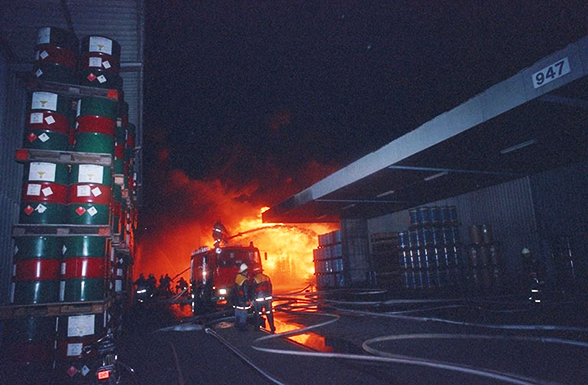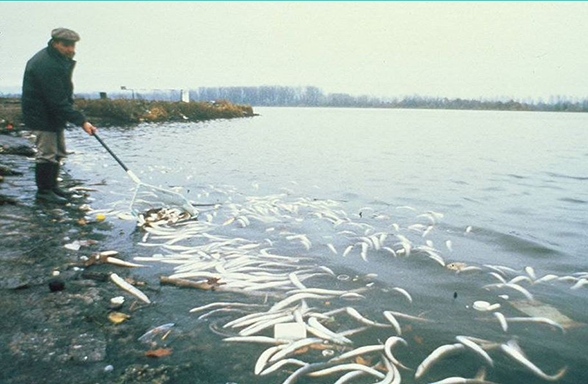
Night owls who are out and about in Pratteln and Muttenz in the early hours of Saturday 1 November were the first to learn of the disaster: shortly after midnight, the fire service had received the report that a fire had broken out in Warehouse 956 in the Schweizerhalle industrial complex. Fire services from numerous Basel communes were called out and 160 firefighters were soon at work. They were faced with a veritable inferno: containers with unknown contents were exploding, fireballs measuring over 50 metres were shooting into the night sky, and some of the firefighters may well have wondered whether their safety equipment would be able to protect them from harm.
Foul-smelling air, closed windows and doors
People sleeping with open windows in close proximity to the fire were woken by a pungent odour which they described as a mixture of rotten eggs, garlic and decaying plants. From 4 am people in Kleinbasel and the lower areas of the canton of Basel-Landschaft were woken by the shrieking of the sirens. The police drove through the neighbourhoods and ordered residents by loudspeaker to close their windows and remain in their houses.
Contradictory information
The fire was not contained until shortly before 7 am, at which point it was possible to issue the all clear. In contrast to the instructions that had been given earlier, children in the Basel region were told to go to school. The contradictory information angered many parents and criticism was also expressed by the residents of neighbouring regions outside Switzerland. No attempt had been made to alert people in south Baden (Germany) and Alsace (France) about the fire; numerous cross-border workers making their way to work were told to go back home - by customs officers wearing gas masks. The management of Sandoz, the company that owned the burnt-down warehouse, provided assurances that the substances stored in it were mostly harmless. The crisis management team, which could not quite believe the reassurances, sent a police patrol on an ornithological mission: they were instructed to observe the birds in the Hardwald forest between Muttenz and Basel which are particularly sensitive to environmental impacts. However, the police officers did not observe anything of particular note; they found no dead animals and the twittering of birds could be heard in the forest as usual.

The damage in the Rhine
The extent of the devastation wreaked on the environment by the fire emerged a few hours later. Over the course of the Saturday it emerged that 20,000 cubic metres of extinguishing water contaminated with highly toxic chemicals, for example pesticides, herbicides and mercury compounds, had been discharged into the Rhine. The river water had turned red. However, unlike the other discharged substances, the dye responsible for this was not toxic.
Dead fish by the tonne
The Basel-Stadt cantonal fishery warden reported on the Monday that over one tonne of dead grayling had been collected. Almost the entire eel population between Schweizerhalle and the Loreley rock near Koblenz, a good 400 kilometres downstream, had also been killed. Finally, the impacts of the chemical contaminants in Holland could mainly be observed in insect larvae and tubifex or sludge worms; the extraction of drinking water from the river was suspended up to Holland.
Just months after the Chernobyl disaster in April 1986, the second biggest environmental disaster of that year further undermined the population's faith in technology.
King of fish at home in the Rhine again
The poisoned fish were a source of major concern to the public. One year after the fire, the International Commission for the Protection of the Rhine (ICPR) launched the Rhine 2000 remediation programme, which aimed to improve the water quality to a level at which life could be re-established in the river. In addition, the Salmon 2000 programme was intended to help the king of fish to feel at home in the river again; fish ladders were constructed with a view to improving the passability of the Rhine and ensuring that the great species could reach its spawning grounds. Salmon have been ascending again from the North Sea via the Rhine delta since 1990 and they have been reproducing naturally in some of the tributaries since 1994. The Salmon 2000 programme was followed up by the Rhine 2020 programme.
Making the river more passable for migratory fish
The ICPR also runs a number of working groups, including the Fish Fauna Expert Group. This group focuses on the topic of fish migration and healthy fish populations, and studies fish as indicators of the quality of the aquatic habitat. It carries out regular monitoring of fish fauna and is responsible for the implementation of the Masterplan Migratory Fish Rhine. This master plan defines detailed measures intended to increase the passability of the Rhine and improve the characteristics of the habitats in particular sections of the river. The Federal Office for the Environment (FOEN) collaborates actively with the Fish Fauna Expert Group.
Soil remediation - a laborious process
Although the damage to the Rhine was the main focus of public interest, the fire in Schweizerhalle also caused extensive damage on dry land.
The contaminated soil in Schweizerhalle was excavated to a depth of 11 metres and washed. A residual load of a few hundred kilograms of the pesticide oxadixyl remained. Other pesticides that also entered the substrate during the extinguishing of the fire in 1986 can no longer be detected in the groundwater today.
As an additional safety measure, the site of the former warehouse was sealed with a concrete slab and the groundwater in this location is pumped out. Today, only low concentrations of oxadixyl - in the range of a few millionths of a gram per litre (µg/L) - can be detected in the groundwater on the accident site. The infiltration of Rhine water into the nearby drinking-water abstraction area of Hardwald, which has existed since 1958, also ensures that the groundwater from the accident site cannot flow into the drinking water catchments of the upper Hard area. The direction of flow and quality of the groundwater is constantly monitored.
The Office for Environmental Protection and Energy of the canton of Basel-Landschaft will carry out a new legal assessment of the Schweizerhalle accident site by early 2017. The need for further monitoring and remediation will be clarified on the basis of this assessment.
Last modification 28.10.2016





